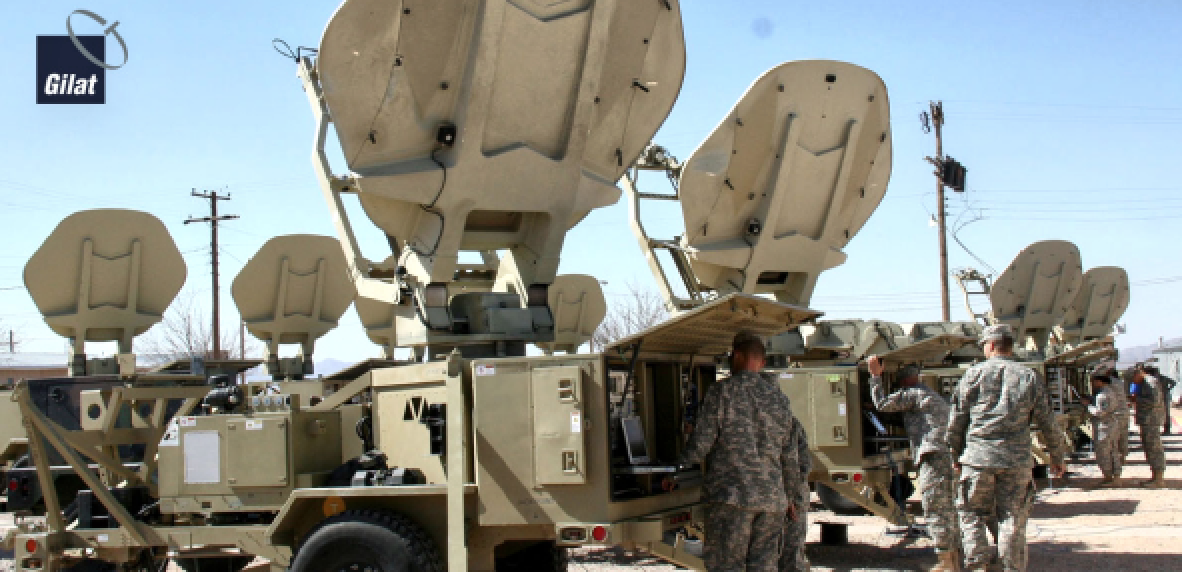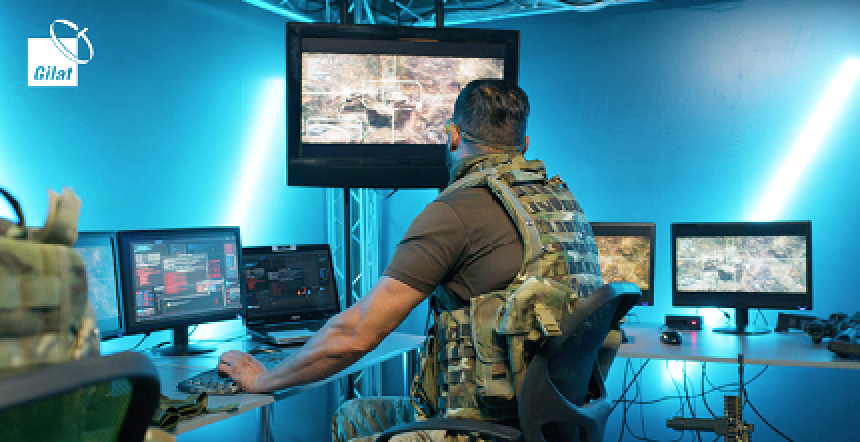Eyal Zelinger is Gilat Satellite Network’s Global Defense Vice President and General Manager. He is a retired Brigadier General (BG) from the Israel Defense Forces (IDF) and leads Gilat’s Defense business to maximize opportunities worldwide. He joined the company on December 1st, 2020. Mr. Zelinger possesses more than 30 years in the Israeli Defense Forces C4I branch. During his service, he managed the development and operation of the IT systems, cyber defense, communication infrastructure, and served IDF’s highest, strategic leadership. He retired at the rank of a Brigadier General after serving as the Chief Signal Officer and C4I (Command, Control, Communications, Computers, & Intelligence)/J6 Chief of Staff, a position he held until August of 2015.

Mr. Zelinger, you had an extraordinary career in the Israel Defense Forces (IDF). How did you find yourself in the Signal Corp and what role did satellite communications play in your work?

Eyal Zelinger
Actually, I started in the Signal Corp on my first day of service. It was ‘assigned’ to me, but obviously it was the perfect fit, as I stayed in the Signal Corp for more than 30 years and retired at the rank of Brigadier General. For me, the Signal Corp represented the ideal combination of operations and technology, allowing me to effectively implement the latest communication technologies for optimal use and results.
My first exposure to satellite communications came when I was a Signal Battalion Commander. We received a command to implement a SATCOM solution to improve operational efficiency. When I was head of C4I system development, I was responsible for all future development and established critical SATCOM capabilities for the entire IDF.
As a former high-ranking military officer, what do you think are the biggest changes happening in today’s modern defense forces?
Eyal Zelinger
Since World War II, a large portion of defense industry spending have been driven by technology. Throughout the second half of the 20th century, technology-based defense grew more prevalent and became the best approach to solve security challenges — at least for the larger, more developed military spenders.
The quest for technological superiority and innovation makes sense when armed forces are trying to preserve and reinforce their strategic advantage. The digital transformation of the military continues to shape the future of global security. Seamless collaboration and communication are crucial for helping defense agencies realize a more modern way of working and managing themselves more effectively; sharing vast amounts of critical information (including voice, data and video) in real time makes military maneuvers more efficient and effective. Now we are well into the 21st century; militaries no longer look like they did in the past. Today’s modern militaries move faster, smarter and with greater precision than ever before, based on information systems which consume high bandwidth.
What exactly is driving these changes? Eyal Zelinger Modern militaries have embraced the concept of “net-centricity.” The theory around net-centricity is fairly simple: by implementing a globally interconnected broadband communication network (including infrastructure, systems, processes, and people) that speeds up 2-way communications and increases situational awareness, the efficiency and effectiveness of military operations will improve.
Vast amounts of data are shared in a timely, seamless and resilient way among warfighters, officers, applications and platforms during all phases of warfighting efforts. This, in turn, allows combat units to be smaller in size, more effective and lethal and allows them to take on a different range of missions than non-networked units. Net-centricity enables the real-time, free flow of information across the battlespace so that data is shared, processed into information and then provided to the people or systems in need. Communications networks are being shaped by Big Data and include Wi-Fi, cellular, voice, video and other technologies. In order to achieve this new level of connectivity and operational continuity, wherever forces may be located and in spite of any enemy efforts to block communication, modern militaries are now using satellite communications (SATCOM) to help ensure the successful completion of land, sea and air missions.
What should defense customers be looking for in Satcom-on- the-Move solutions?
Eyal Zelinger
Wartime and tactical missions often take forces into unfamiliar territory crawling with unpredictable and unknown threats. Access to real-time intelligence on the ground — where and when troops need it — can make all the difference between a successful and an aborted mission. Combat troops need fast, reliable and secure communications in areas beyond the bounds of traditional fixed and wireless networks. Satellite-on-the-move (SOTM) communications is a game-changer for today’s net-centric battlefield, enabling soldiers and homeland security personnel to gain instant access to critical information while staying in touch with command headquarters.
Defense organizations need quick-to-deploy ruggedized SOTM solutions that can be carried in a backpack or mounted on fighting vehicles. More specifically, they should look for fully integrated VSAT systems that ensure seamless connectivity for both on-the-move and on- the-pause missions and support voice and data communications, military C4I and border patrol activities with full interoperability among land, sea and airborne forces.
Tell us something about Gilat’s products and solutions offerings? What is unique about them? What makes Gilat’s offering unique compared to others on the market?
Eyal Zelinger
I must start with the Defense Team here at Gilat. We all came with extensive operational experience from today’s modern battlefield. As such, we understand what is needed today and what will be needed in the future and guide product and solution development accordingly. Gilat offers government and defense organizations a set of advanced SOTM solutions for all types of platforms in order to keep assets in the field.
What exactly is driving these changes? Eyal Zelinger Modern militaries have embraced the concept of “net-centricity.” The theory around net-centricity is fairly simple: by implementing a globally interconnected broadband communication network (including infrastructure, systems, processes, and people) that speeds up 2-way communications and increases situational awareness, the efficiency and effectiveness of military operations will improve.
Vast amounts of data are shared in a timely, seamless and resilient way among warfighters, officers, applications and platforms during all phases of warfighting efforts. This, in turn, allows combat units to be smaller in size, more effective and lethal and allows them to take on a different range of missions than non-networked units. Net-centricity enables the real-time, free flow of information across the battlespace so that data is shared, processed into information and then provided to the people or systems in need. Communications networks are being shaped by Big Data and include Wi-Fi, cellular, voice, video and other technologies. In order to achieve this new level of connectivity and operational continuity, wherever forces may be located and in spite of any enemy efforts to block communication, modern militaries are now using satellite communications (SATCOM) to help ensure the successful completion of land, sea and air missions.
What should defense customers be looking for in Satcom-on- the-Move solutions?
Eyal Zelinger
Wartime and tactical missions often take forces into unfamiliar territory crawling with unpredictable and unknown threats. Access to real-time intelligence on the ground — where and when troops need it — can make all the difference between a successful and an aborted mission. Combat troops need fast, reliable and secure communications in areas beyond the bounds of traditional fixed and wireless networks. Satellite-on-the-move (SOTM) communications is a game-changer for today’s net-centric battlefield, enabling soldiers and homeland security personnel to gain instant access to critical information while staying in touch with command headquarters.
Defense organizations need quick-to-deploy ruggedized SOTM solutions that can be carried in a backpack or mounted on fighting vehicles. More specifically, they should look for fully integrated VSAT systems that ensure seamless connectivity for both on-the-move and on- the-pause missions and support voice and data communications, military C4I and border patrol activities with full interoperability among land, sea and airborne forces.

Tell us something about Gilat’s products and solutions offerings? What is unique about them? What makes Gilat’s offering unique compared to others on the market?
Eyal Zelinger
I must start with the Defense Team here at Gilat. We all came with extensive operational experience from today’s modern battlefield. As such, we understand what is needed today and what will be needed in the future and guide product and solution development accordingly. Gilat offers government and defense organizations a set of advanced SOTM solutions for all types of platforms in order to keep assets in the field connected at all times to central operations. Our high-performance and quick-to-deploy systems provide fast and reliable broadband connectivity for any mission, as well as supporting a diverse range of civilian services.
More specifically, Gilat’s end-2-end SATCOM solutions have been designed specifically to meet the needs of today’s net-centric battlefield, including: flexible, secure platforms for huge amounts of data and high-bandwidth applications to connect soldiers, platforms and terminals across land, sea and air; continuous and resilient connectivity to ensure that information is available when, where and how it is needed; with all necessary technology, equipment, applications, products and solutions under 1 roof.
Gilat’s full scale, state of the art SATCOM solutions are fully equipped to provide the constant flow of 2-way secured broadband communication required by today’s net-centric battlefield, including intelligence, live video, voice, command and control information and enemy/friendly forces locations and operational commands.
Offering antennas, modems, BUCs, manpacks and unmanned platforms, Gilat supports any SOTM/SOTP use case and any platform.

What are some examples of use cases for Gilat’s Defense products?
Eyal Zelinger
The ability to integrate wide-band communication between air, land and sea is critical for defense operations. I personally experienced this need in 2014 during“OperationProtectiveEdge” when I was Chief Signal Officer of the IDF.
Terrorists had infiltrated Israel via the beach; however, the Navy didn’t have any ‘eyes’ on what was happening beyond the sand. In these types of cases, HQ can deploy Gilat’s Blackray, an unmanned aircraft (UAV), to survey the landscape and send back video to be analyzed by the command- and-control center. Tactical unmanned aircraft systems (UAS) are often capable of long endurance times while carrying significant payload weight. SATCOM fully exploits tactical UAS capabilities, supports intelligence, surveillance and reconnaissance (ISR) missions beyond line of sight (BLOS). Based on the information provided by the UAV, artillery units are safely moved closer to the border and a Navy offshore patrol vessel hugs the coast. In a completely coordinated mission and based on common situational awareness,theterroristsarecaught. All forces involved have a common picture of what is happening and can choreograph their actions as the situation unfolds.
In another example, ground troops are activated to enter a city in order to remove enemy forces planning a terrorist attack. Historically, warfighters in this situation go in ‘blind,’ meaning they have no situational awareness as to what is happening behind the closed doors of houses, offices, warehouses, etc.
Warfighters have no choice but to go door to door, hoping to avoid injury to the innocent and capturing the fugitives without incident. However, with the use of SOTM technology, warfighters can enter battlefields with their eyes wide open. In this scenario, data and video are collected via a number of different applications and sent back to HQ and to the forces in real time via Gilat’s ruggedized SOTM antennas.
The information is reviewed and analyzed by intelligence officers who, in turn, are able to advise warfighters on the ground exactly which properties to approach and which to avoid. Another critical use of SATCOM involves paratroopers using Manpacks. Paratroopers are trained to conduct a range of missions, from prevention and pre-emption tasks, to complex, high intensity war fighting. They are often the first on the ground during an incursion and are responsible for a tremendous amount of intelligence gathering.
Using Gilat’s fully integrated and lightweight SatTrooper manpacks, which provide rapid connectivity to voice, data and telephony, even under the harshest conditions, paratroopers are able to share invaluable information to command and control. The small-size dish antenna can be set up within minutes, with automatic pointing, and does not require any special tools for assembly.
You probably had your choice of private sector job opportunities after you retired from the IDF. How did you decide to work for Gilat?
Eyal Zelinger
For more than 30 years, Gilat has been a pioneer and leading innovator in SATCOM. I was fortunate to work with Gilat during my service so I knew that the team leverages its commercial technological leadership and innovation to provide SATCOM solutions to governments around the world to answer all of the broadband communication needs required by today’s modern battlefield. In addition, I knew that military SATCOM is in Gilat’s DNA.
Many members of Gilat’s executive team, solution experts and R&D engineers have extensive military experience across a wide range of disciplines and expertise, making Gilat the best choice for serving the needs of today’s defense forces that must use the latest in critical SATCOM technology.
www.gilat.com/solutions/defense-and-government/


